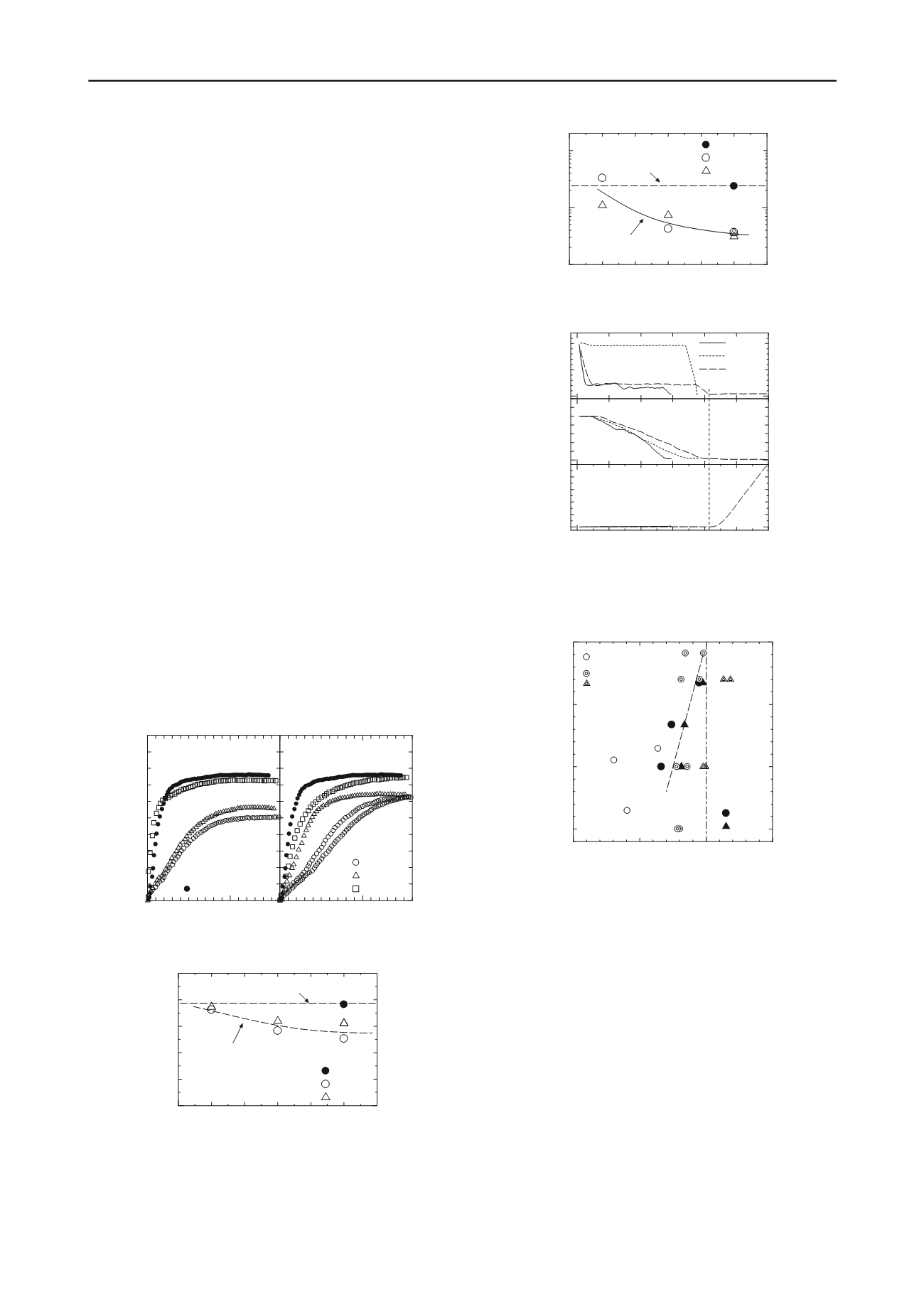
456
Proceedings of the 18
th
International Conference on Soil Mechanics and Geotechnical Engineering, Paris 2013
(high gas concentration) and the reference samples (low gas
concentration) on same area. On the other hand, test results of
Luune et al. (2001) are for samples permeated CH
4
gas
dissolved water under the different pressure (0 to 15 MPa), as
similar to this study method.
0 100 200 300 400 500 600
0.1
1
10
E
50
(MN/m
2
)
Back pressure (kPa)
: Case 1
Case 1
Case 2, 3 (CO
2
dissolved water)
: Case 2
: Case 3
(deaired water)
It is found from this figure that the strength ratios decrease
with the increase of water depth. In other words, it is found that
the effects of the sample disturbance become large with the
increase of gas concentration (water depth). Although the
results of Kataoka et al. have some scatter, the reduction of
strength with depth is larger than that in this study. This reason
seems that the effects of the sample disturbance in intact
samples are larger than those in reconstituted samples. On the
other hand, the reduction of strength in the results of Lunne et
al. is lower than in this study. It would seem that the effects of
the sample disturbance were decreased by the reconsolidation
during the triaxial test. From these test results, it would seem
that the in-situ strength can be estimated roughly from the
disturbed samples retrieved from deep lake bottom by the
measuring the concentration of dissolved gas.
Figure 9. Relations of deformation modulus and back pressure.
0
50
100
0.0
0.1
0.2
0.3
0.4
0.5
0.6
0 100 200 300 400 500 600
0.0
2.0
4.0
6.0
8.0
v
(kPa)
B.P. (MPa)
Axial Dis. (mm)
Time (sec)
: Case 1
Consolidation stress: 100 kPa
: Case 2
: Case 3
Back pressure: 500 kPa
5 CONCLUSIONS
The strength of samples retrieved from GH-bearing ground is
decreased by the sample disturbance due to the exsolution of
dissolved gas during the sampling. The reduction of strength
becomes large with the increase of dissolved gas concentration.
From the laboratory tests which simulate the stress relief
from bringing the samples to the lake surface, it was recognized
that the effects of the sample disturbance become large with the
increase of gas concentration. It was also showed that the in-situ
strength can be estimated roughly from the disturbed samples.
Figure 10. Time histories of vertical stress, back pressure and axial
displacement.
1500
1000
500
0
0.0
0.5
1.0
1.5
q
u (Case 2, 3)
/
q
u (Case 1)
water depth
: Case 2
: Case 3
:Kataoka et al. 2009
:Lierstranda clay
:Bothkennar clay
(Lunne et al. 2001)
6 ACKNOWLEDGEMENTS
The authors would like to thank Dr. Oleg Khlystov of the
Russian Limnological Institute, Prof. Hitoshi Shoji, Dr.
Hirotsugu Minami and Dr. Akihirio Hachikubo of Kitami
Institute of Technology for their cooperation in the survey.
0
5
10
15
0
10
20
30
40
50
0
5
10
15
Axial stress ,
(kN/m
2
)
Axial strain ,
(%)
: 500 kPa
: 300 kPa
Back pressure
Case 3
Case 2
: 100 kPa
: 500 kPa (Case 1)
Figure 11. Relations of strength ratio and water depth.
7 REFERENCES
Matveeva, T.V., Mazurenko, L.L., Soloviev, V.A., Klerkx, J., Kaulio,
V.V. and Prasolov, E.M. 2003. Gas hydrate accumulation in the
subsurface sediments of Lake Baikal (Eastern Siberia) ,
Geo-
Marine Letters
, 23(3-4), 289-299.
Figure 7. Unconfined compression test results.
Kataoka, S., Yamashita, S., Kawaguchi, T. and Suzuki, T. 2009. The
soil properties of lake-bottom sediments in the Lake Baikal gas
hydrate province,
Soils and Foundations
, 49(5), 757-775.
0 100 200 300 400 500 600
0
10
20
30
40
50
q
u
(kN/m
2
)
Back pressure (kPa)
: Case 1
Case 1 (deaired water)
Case 2, 3 (CO
2
dissolved water)
: Case 2
: Case 3
Hachikubo, A., Khlystov, O., Sakagami, H., Minami, H., Yamashita, S.,
Takahashi, N., Shoji, H., Kalmychkov, G. and Poort, J. 2010.
Isotopic fractionation of hydrate-bound hydrocarbons in the
subbottom sediments of Lake Baikal,
2010 AGU Fall Meeting
, San
Francisco, USA.
Lunne, T., Berre, T., Strandvik, S., Andersen, K.H. and Tjelta, T.I. 2001.
Deepwater sample disturbance due to stress relief,
Proc.
Geotechnical, Geological, and Geophysical Properties of
Deepwater Sediments
, Texas, USA, NGI Rapport 521671-10.
Figure 8. Relations of unconfined compression strength and back
pressure.
Yamashita, S., Moriwaki, T., Hachikubo, A., Minami, H., Shoji, H.,
Kawaguchi, T. And Kataoka, S. 2011. Strength change of seabed
soils due to the vaporization of dissolved gas in the pore water,
Proc. of the Inter. Sym. on Deformation Characteristics of
Geomaterials
, Seoul, Korea, 905-910.


